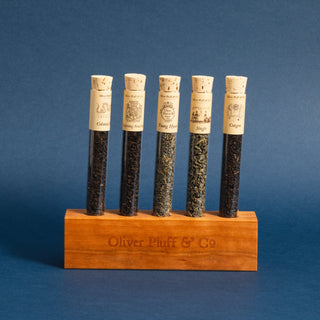Teas of the Boston Tea Party
Teas of the Boston Tea Party
Colonial Bohea (pronounced “Boo-hee” - Ukers 510), was by far the largest tea import during colonial times. Sometimes called Bohea Souchong or Lapsang Bohea, the blend originated in China with trade to the British and Dutch East India Companies. It was so popular that the word bohea became the slang term for tea. The blend varied wildly, consisting of broken orange pekoe, pekoe, and souchong dumped in a pile and then sifted, typically the scrap tea of lower quality leaves, but was considered high quality by the colonists.
Congou Grown in Southern China, Congou is one of the last of its kind, one of the great historical teas of China from its trading days. The word Congou refers to a tea made with highest mastery or careful skill to produce thin, light strips without breaking the leaves. The resulting toasty black tea is smooth and sweet with the flavor of unsweetened baked apples.
Young Hyson Green tea. Made from young leaves that are thinly rolled to have a long, twisted appearance that unfurls when brewed. Some believe it to have been named after an English tea merchant, Phillip Hyson. Hyson and Young Hyson tea were highly prized by the colonial Americans and tax on hyson was higher than for other teas. During the Boston Tea Party there were 70 chests of Hyson destroyed.
Lapsang Souchong Lapsang's flavor is strong and smoky - meant to complement to the natural taste of black tea, without overpowering. The British East India Company included Souchong teas as its common imports to colonial America. In the Boston Tea Party, 35 chests of Souchong tea were destroyed.
Singlo This green tea is picked later in the season of larger leaves, is pan-fried and then curled and dried, yielding a buttery green tea infusion with a plum-like finish.
Size/Type: 5 glass tubes filled with approx. 9-15g of loose tea each.
Shelf Life: 3 Years
Hand packaged by Oliver Pluff & Co in Charleston, South Carolina.
Teas of the Boston Tea Party
Colonial Bohea (pronounced “Boo-hee” - Ukers 510), was by far the largest tea import during colonial times. Sometimes called Bohea Souchong or Lapsang Bohea, the blend originated in China with trade to the British and Dutch East India Companies. It was so popular that the word bohea became the slang term for tea. The blend varied wildly, consisting of broken orange pekoe, pekoe, and souchong dumped in a pile and then sifted, typically the scrap tea of lower quality leaves, but was considered high quality by the colonists.
Congou Grown in Southern China, Congou is one of the last of its kind, one of the great historical teas of China from its trading days. The word Congou refers to a tea made with highest mastery or careful skill to produce thin, light strips without breaking the leaves. The resulting toasty black tea is smooth and sweet with the flavor of unsweetened baked apples.
Young Hyson Green tea. Made from young leaves that are thinly rolled to have a long, twisted appearance that unfurls when brewed. Some believe it to have been named after an English tea merchant, Phillip Hyson. Hyson and Young Hyson tea were highly prized by the colonial Americans and tax on hyson was higher than for other teas. During the Boston Tea Party there were 70 chests of Hyson destroyed.
Lapsang Souchong Lapsang's flavor is strong and smoky - meant to complement to the natural taste of black tea, without overpowering. The British East India Company included Souchong teas as its common imports to colonial America. In the Boston Tea Party, 35 chests of Souchong tea were destroyed.
Singlo This green tea is picked later in the season of larger leaves, is pan-fried and then curled and dried, yielding a buttery green tea infusion with a plum-like finish.
Size/Type: 5 glass tubes filled with approx. 9-15g of loose tea each.
Shelf Life: 3 Years
Hand packaged by Oliver Pluff & Co in Charleston, South Carolina.



